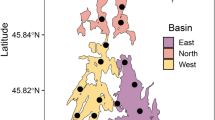Abstract
Instruments were attached to loggerhead turtles, Caretta caretta, at Kamoda Point, Japan in 1989 and on the Senri-coast, Japan in 1991. We simultaneously obtained stomach temperatures, ambient water temperatures and diving depths from four free-ranging loggerhead turtles during the internesting periods, using small recorders. These data were analyzed to understand how body temperature was maintained. Ambient water temperatures changed coincidentally when turtles moved up or down, but a stable stomach temperatures was maintained despite water temperature fluctuations of ca. 20 to 90 min in duration. Loggerhead turtles also experienced water temperature fluctuations longer than 24 h. Stomach temperatures responded to those water temperature changes with a time lag of several hours (160, 170, 230 and 240 min). Stomach temperatures were higher than ambient water temperatures throughout the experimental periods. The median values of the thermal difference between stomach and water temperatures were 1.1, 1.3, 1.5 and 1.7°C. The higher stomach temperatures are thought to be caused by metabolic heat production.
Similar content being viewed by others
References
Frair, W., Ackman, R. G., Mrosovsky, N. (1972). Body temperature of Dermochelys coriacea: warm turtle from cold water. Science, N. Y. 177: 791–793
Heath, M. E., McGinnis, S. M. (1980). Body temperature and heat transfer in the green sea turtle, Chelonia mydas. Copeia 4: 767–773
Naito, Y., Le Boeuf, B. J., Asaga, T., Huntley, A. C. (1989). Longterm diving records of an adult female Northern elephant seal. Antarctic Rec. 33(1): 1–9
Mrosovsky, N. (1980). Thermal biology of sea turtles. Am. Zool. 20: 531–547
Mrosovsky, N., Pritchard, P. C. H. (1971). Body temperature of Dermochelys coriacea and other sea turtles. Copeia 4: 624–631
Sakamoto, W., Yuzuriha, H. (1993). Tracking free-swimming marine animals. Sea Technol. 34(2): 25–27
Sapsford, C. W., van der Riet, M. (1979). Uptake of solar radiation by the sea turtle, Caretta caretta, during voluntary surface basking. Comp. Biochem. Physiol. 63: 471–474
Smith, E. N., Long, N. C., Wood, J. (1986). Thermoregulation and evaporative water loss of green sea turtles, Chelonia mydas. J. Herpetol. 20(3): 325–332
Spotila, J. R., Lommen, P. W., Bakken, G. S., Gates, D. M. (1973). A mathematical model for body temperature of large reptiles: implications for dinosaur ecology. Am. Nat. 107(955): 391–404
Standora, E. A., Spotila, J. R., Foley, R. E. (1982). Regional endothermy in the sea turle Chelonia mydas. J. therm. Biol. 7: 159–165
Uchida, I. (1981). Nesting behavior of the loggerhead turtle along the coast of Japan (in Japanese). Saishu to Shiiku 43: 472–476
Author information
Authors and Affiliations
Additional information
Communicated by T. Ikeda, Nagasaki
Rights and permissions
About this article
Cite this article
Sato, K., Sakamoto, W., Matsuzawa, Y. et al. Correlation between stomach temperatures and ambient water temperatures in free-ranging loggerhead turtles, Caretta caretta . Marine Biology 118, 343–351 (1994). https://doi.org/10.1007/BF00349802
Received:
Accepted:
Issue Date:
DOI: https://doi.org/10.1007/BF00349802




